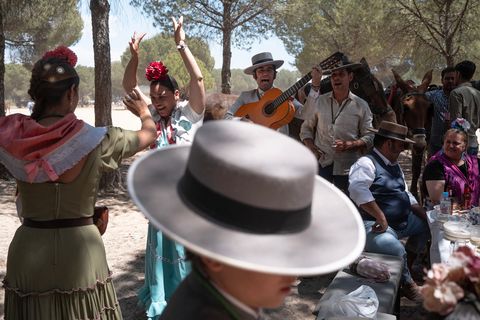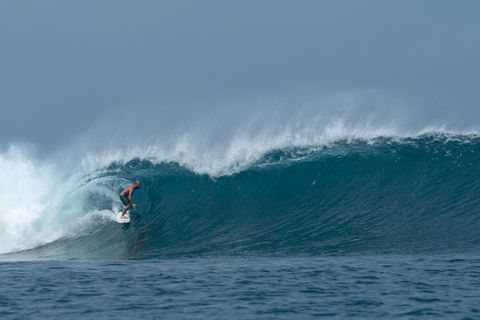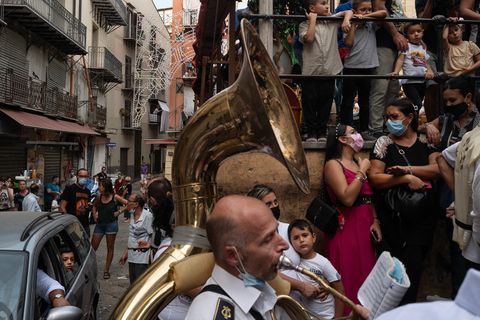Travel
The El Rocio Pilgrimage
It was hard to make out the face through all of the dust, but the man’s old-fashioned clothing gave him away. A flat-brimmed sombrero Cordobés sat on his head. He strummed a guitar from atop an Andalusian horse. There was no question why he was here trotting the road to this village between Seville and the Gulf of Cádiz on this day in May.
In front of the rider, in the back of a covered wagon adorned with colorful flowers, a group of women wore traditional flowing dresses adorned with polka dots and floral patterns. They drank manzanilla wine as they sang and clapped in a hypnotic rhythm.
A foreigner’s thoughts of Spain are often populated with the potent and romantic imagery of Andalusia: flamenco, the magnificent horse culture, processions and the seductive sound of the canto profundo. The El Rocío pilgrimage embodies all of that imagery.
Surfing's Shangri La
In 1991, an Australian named Lance Knight came upon a perfect wave. Brushed by gentle offshore winds and gleaming in the afternoon sunshine, the hollow wall of water broke over a shallow coral reef now known to surfers as the “surgeon’s table” for the amount of flesh it has consumed. It was the stuff of teenage daydreams, shaped as if it had been ripped straight from a notebook drawing. As far as anybody knows, no one had ridden it before.
Like the surf across many of the some 17,000 islands that make up Indonesia, the conditions on this remote beach were world-class. But unlike Bali, Java and Nias, Sipura Island was virtually unknown to foreigners.
Located about 90 miles off the coast of West Sumatra, Sipura is part of the Mentawai Islands Regency, a small chain that has achieved mythical status in the surfing community for its abundance of tropical perfection — and the complicated travel logistics required to reach it. As the Mentawais became a surfing destination, the wave Knight discovered became “Lance’s Right,” just one example of the scores of pristine swells tracking east to west out of the Indian Ocean.
For better or for worse, the Mentawais are undergoing a sea change. Locals say the rush was on by 2015. Surf resorts and camps began appearing near all the premier breaks, and now there are more than 50 charter boats ferrying frothing surfers who come from around the world. According to Statistics Indonesia, the number of international tourists to visit the Mentawais steadily grew from 4,120 in 2011 to 6,569 in 2015 to 12,325 in 2018.
Australia's Outback Way
What could have been better for celebrating my reporting partner’s 39th birthday than a feast of two microwaveable “pub-sized” meals at a lonely Australian roadhouse some 150 miles from nowhere?
Covered in dust, we’d arrived at the Tjukayirla Roadhouse — pronounced “Chook a-year-la” — and claimed by its owners to be the most remote stop on the continent. That seemed an accurate description. All was quiet save for a desert breeze as we started in on the birthday dinner of chicken Kiev, and bangers and mash. A dingo roamed the grounds as we ate.
So goes life on the loneliest stretch of the 1,700-mile Outback Way, the grueling route, often unpaved, that cuts across the country’s arid interior.
There are plans to seal the entirety of the road. Many local communities welcome the news, the road is dangerous and has claimed many lives. They hope that economic prosperity will accompany the decreased isolation.
Sicily's Leap of Faith
The island of Sicily has been overrun and conquered by numerous empires and civilizations. The year 2020 brought a new and deadly conqueror, the coronavirus. The lockdown was absolute — even church doors were shut tight. But in 2021, Sicilians brought life and traditions back to their streets.
Saint’s days, or festas, are important events on the Sicilian calendar. Last year, for the first time in more than a century, some towns canceled their festas. The arrival of vaccines this year seemed to offer hope that the processions would once again march down the ancient streets. However, a surge in summer tourism, while helping the local economy, also boosted the coronavirus infection rate.
Sicily has the lowest vaccination rate in Italy. Nevertheless, scaled-down celebrations have reappeared in the island’s streets. In the capital city of Palermo, residents gathered for the festa honoring the Maria della Mercede (Madonna of Mercy), which dates to the 16th century. Children were hoisted aloft to be blessed by the Virgin as a marching band played in a small piazza fronting the church that bears her name. Local bishops did not permit the normal procession because of the pandemic, so local children had their own, carrying a cardboard re-creation of the Virgin through the labyrinth of the famous Il Capo district’s narrow streets.
As the fireworks blossomed overhead and the marching band played on, it was easy to see that Sicilians were embracing a centuries-old tradition that seems certain to last for many more to come.


